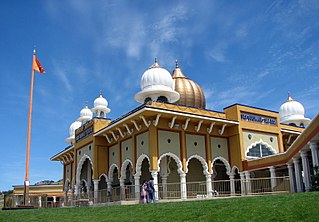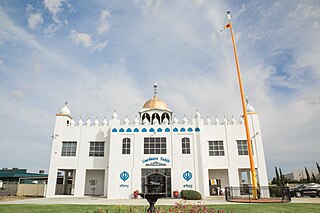Sandeep Singh Brar | |
|---|---|
 | |
| Born | Kisumu, Kenya, Africa |
| Website | www.sikhs.org www.sikhmuseum.com www.singhbrar.com/photos/ |
Sandeep Singh Brar is a Sikh historian, internet pioneer and photographer.
Sandeep Singh Brar | |
|---|---|
 | |
| Born | Kisumu, Kenya, Africa |
| Website | www.sikhs.org www.sikhmuseum.com www.singhbrar.com/photos/ |
Sandeep Singh Brar is a Sikh historian, internet pioneer and photographer.
He is the creator of the world's first Sikh website, sikhs.org, which was launched in December 1994. [1] The website consisted mostly of bulletin boards where discussions on topics such as hair-cutting, meat-consumption, caste, conflicts between Punjabi culture and Sikhism, Sikh & non-Sikh relations, gender, and other matters were discussed. [1] The website featured news stories related to diasporic Sikhs, offering a central hub for the collection of these articles. [1] In September 1995, The Sikhism Home Page was included into the Microsoft Encarta Encyclopedia, and continues to be one of the mostly highly referenced sources of information about the Sikh religion. [2]
He is also the first person to put the Sikh Scriptures on the Internet with the full English translation of The Guru Granth Sahib by Dr. Sant Singh Khalsa and first to put the Sikh Code of Conduct - The Sikh Rehat Maryada on the Internet. In addition to this site, Sandeep Singh Brar is also the creator of the SikhMuseum.com website, whose purpose is to preserve the heritage of the Sikh people in a way that is accessible to all.
In 2008, Sandeep Singh was responsible for uncovering the history and life of Private Buckam Singh, one of only a handful of Sikh soldiers that served in the Canadian military during World War I. [3] [4] [5] It was the acquisition of a forgotten World War I medal that prompted Sandeep Singh to research its ownership, thus bringing to light the story of the brave Canadian Sikh. A ceremony was held at Buckam Singh's grave in Kitchener, Ontario on November 11 (Remembrance Day) to commemorate his service and life. [6] [7]
In addition to being a historian, Sandeep Singh is also a noted photographer [8] whose works have been featured in a number of exhibits:
September 2006 – January 2007: Rubin Museum of Art, New York I See No Stranger: Early Sikh Art and Devotion Photographs incorporated as part of the exhibit
2004–2007: Smithsonian Institution, Washington D.C. Sikhs: Legacy of the Punjab Photographs incorporated as part of the exhibit
1999: Metro Toronto Convention Centre Centennial Foundation Gala Solo exhibit of photographs

The Namdharis, also known as Kuka and Kukaism, are a Sikh sect that differs from mainstream Sikhs chiefly in that it believes that the lineage of Sikh Gurus did not end with Guru Gobind Singh (1666–1708), as they recognize Balak Singh (1797–1862) as the 11th Guru of the Sikh religion, thus continuing the succession of Sikh Gurus through the centuries from Guru Nanak Dev to the present day. The 12th Guru was Ram Singh (1816–1885), who moved the sects centre to Bhaini Sahib (Ludhiana) and is regarded as the first Indian to use non-cooperation and non-violence boycott in order to combat the British Empire in India.
Sidhu is a Punjabi Jat clan found in Punjab.

Sri Muktsar Sahib district, is one of the 23 districts in the Indian state of Punjab. The capital city of district is Sri Muktsar Sahib. The district itself was historically referred as Khidrane Di Dhaab. There are 4 Tehsils in District which consists of total 234 villages. 1. Sri Muktsar Sahib 2. Lambi 3. Gidderbaha 4. Malout

Moga district is one of the twenty-two districts in the state of Punjab, India. It became the 17th district of Punjab State on 24 November 1995 cut from Faridkot district. Moga District is among the largest producers of wheat and rice in Punjab, India. People from Moga City and Moga District belong to the Malwa culture. The district is noted for being the homeland for a high proportion of Indian Punjabi expatriates who emigrated abroad and their descendents, which has given it the nickname of "NRI district".

Sikh architecture is a style of architecture that was developed under the Sikh Confederacy and Sikh Empire during the 18th and 19th centuries in the Punjab region. Due to its progressive style, it is constantly evolving into many newly developing branches with new contemporary styles. Although Sikh architecture was initially developed within Sikhism its style has been used in many non-religious buildings due to its beauty. 300 years ago, Sikh architecture was distinguished for its many curves and straight lines; Keshgarh Sahib and the Harmandir Sahib are prime examples.

American Sikhs form the country's sixth-largest religious group. While the U.S. Census does not ask about religion, 70,697 Americans declared Sikh as their ethnicity in the 2020 census. The U.S. Census Bureau cites the 2008 American Religious Identification Survey's estimate of the adult Sikh American population at 78,000. The Pew Research Center estimated the Sikh American adult population to be 140,000 and the total population at 200,000 in 2012 while the World Religion Database at Boston University estimated the American Sikh population to be at 280,000 in 2012. Sikh organizations like the Sikh Coalition and American Sikh Congressional Caucus estimate the Sikh American population to be as high as 1,000,000, but do not provide any sources for these figures; 500,000 nevertheless remains the most cited Sikh American population size. With 1% of Asian Americans being Sikh, and 90.7% of Sikh Americans being Asian American, the American Sikh population can be estimated at around 200,000–300,000 in 2021. The largest Sikh populations in the U.S. are found in California (52%), New York (11%), and Washington (6%).

Sikhismin Canada has nearly 800,000 adherents who account for 2.1% of Canada's population as of 2021, forming the country's fastest-growing and fourth-largest religious group. The largest Sikh populations in Canada are found in Ontario, followed by British Columbia and Alberta. As of the 2021 Census, more than half of Canada's Sikhs can be found in one of four cities: Brampton (163,260), Surrey (154,415), Calgary (49,465), and Edmonton (41,385).

Narinder Singh Kapany was an Indian-American physicist best known for his work on fiber optics. Kapany is a pioneer in the field of fiber optics, known for coining and popularising the term. Fortune named him one of seven "Unsung Heroes of the 20th Century" for his Nobel Prize-deserving invention. He was awarded India's second highest civilian award, the Padma Vibhushan, posthumously in 2021. He served as an Indian Ordnance Factories Service (IOFS) officer. He was also offered the post of Scientific Adviser to the Defence Minister of India, by the first Prime Minister of India, Jawaharlal Nehru. He is considered the father of Fiber Optics.

Australian Sikhs number over 210,000 people and account for 0.8% of Australia's population as of 2021, forming the country's fastest-growing and fifth-largest religious group. The largest Sikh populations in Australia are found in Victoria, followed by New South Wales and Queensland.

Ramgarhia Bunga or Burj is the three-storeyed red stone watchtowers complex located near southeastern edge of the Golden Temple, Amritsar. The two minaret-style Ramgarhia Bunga high towers are visible from the parikrama (circumambulation) walkway around the Harmandir Sahib Sarovar. It is a pre-Ranjit Singh structure built by Sikh warrior and Ramgarhia misl chief Jassa Singh Ramgarhia in late 18th-century, after the 1762 destruction and desecration of the Sikh holy temple and site by the Afghan Muslim forces led by Ahmed Shah Abdali. The Bunga watchtowers-related infrastructure was constructed to station sentinels to watch for any surprise attack, house soldiers to help fortify the area, and to protect the holy complex from desecration.
Sikhs: Legacy of the Punjab was a temporary exhibit at the Smithsonian Institution's National Museum of Natural History that highlights the art, culture, and history of the Sikh people. It was dedicated and opened to the public on July 24, 2004 and is a part of the broader Smithsonian Sikh Heritage Project which was launched in 2000. It then traveled to venues in California and Texas.
Adesh Kanwarjit Singh Brar was an Indian farmer, politician and Congress MLA from the Punjab state of India. He was the son of former Chief Minister of Punjab, Harcharan Singh Brar. He completed his schooling from The Doon School (1957). Became an MLA in 1977, 2007 respectively.
The 1947 Partition Archive is a 501(c)(3) non-profit oral history organization in Berkeley, California, and a registered trust in Delhi, India, that collects, preserves, and shares first-hand accounts of the Partition of India in 1947.

The Black Prince is a 2017 international historical drama film directed by Kavi Raz and featuring the acting debut of Satinder Sartaaj. It tells the story of Duleep Singh, the last Maharajah of the Sikh Empire and the Punjab region, and his relationship with Queen Victoria.

Amandeep Sandhu is a Punjabi writer and journalist who writes in English. His second novel Roll of Honour was nominated for Hindu Literary Prize for Best Fiction in 2013.

Photography in India refers to both historical as well as to contemporary photographs taken in modern-day India.

August Theodor Schoefft was a 19th-century Hungarian painter. He spent more than one year in the Sikh Empire, arriving in 1841, where he painted portraits and scenes of the surrounding area. His best known works include The Court of Lahore and Maharaja Ranjit Singh at Darbar Sahib. A painting by Scheofft sold at Christie's for over £91,250 in 2009.